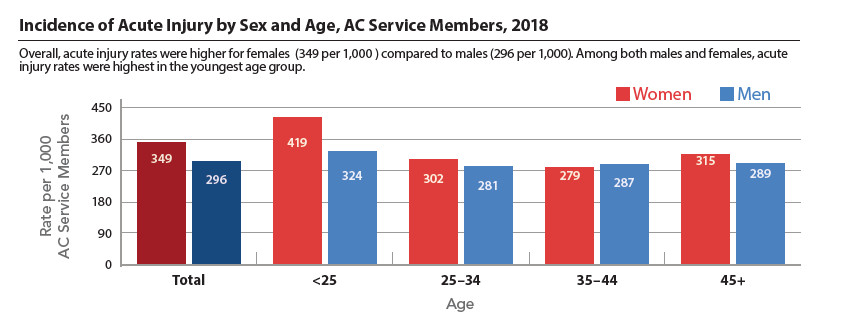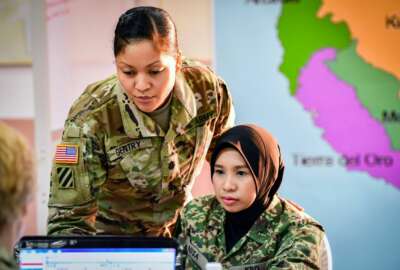
After 70 years of integration, military health system still isn’t addressing women’s needs
A year-long study by the Defense Health Board suggests the Pentagon is not providing proper medical care to women, wasting money and hurting retention and readi...
The DoD Reporter’s Notebook is a weekly summary of personnel, acquisition, technology and management stories that may have fallen below your radar during the past week, but are nonetheless important. It’s compiled and published each Monday by Federal News Network DoD reporters Jared Serbu and Scott Maucione.
Defense health is failing women, study says
A prominent government panel says the Defense Department is failing to provide proper medical care to military women, potentially harming the chance to retain talented female service members.
Even though some military services have made recent changes — like offering refrigerators for women to store breast milk and trying to find better ways for women pilots to use the bathroom in-flight — a yearlong study by the Defense Health Board suggests the Pentagon is not providing proper medical care to women, and therefore wasting money and hurting readiness.
Despite multiple studies going back decades, the military’s one-size-fits-all approach to healthcare leaves women challenged with musculoskeletal injuries, reproductive and genitourinary issues and improper mental health care.
“Active duty women continue to experience high rates of stress fractures and other musculoskeletal injuries, urogenital infections, unintended pregnancies, sexual violence, anxiety, depression, adjustment disorders, and eating disorders. These conditions adversely affect active duty women’s readiness and health,” the authors conclude.
A lot of problems stem from clothing and equipment. Clothing and armor made for men cause issues for women, the lack of proper footwear and the need for better support through sports bras also contribute.
Access to contraceptive services and sexual education differs between services and influences the rate of unintended pregnancies, the board states.
There is also variability in screening protocols for eating disorders — a mental health issue that disproportionately affects women — which causes “stark differences” in the reported prevalence of diagnoses, the board said.
Those issues compounded with sexual harassment and assault, and the higher prevalence of women to leave the military for family reasons results in many fewer women staying in the service and reaching leadership positions.
Previous studies have fallen on ears unwilling to listen, according to the board.
“The differential incidence of these conditions among active duty women have persisted despite 70 years of integration efforts and the creation of more than 10 advisory and decision-making groups, specifically created to improve active duty women’s health, fitness, safety, and performance,” the authors of the report stated. “The groups capably identified best practices and recommended their adoption. But, lacking authority and accountability, few of their recommendations have been implemented.”
To remedy the situation, the health board recommends DoD establish an overarching office to approve recommendations related to women’s health, fitness safety and performance.
The office would focus on minimizing gender-associated differences in healthcare delivery, personnel, research, supply chains and policies. It would also look for traditional male-centric values within the culture that are harming health.
DHB also suggests looking into training programs.
“Basic training and ongoing fitness-for-duty evaluations have two foundational fitness components: health fitness standards that are gender-specific, and occupationally-focused fitness standards that should be gender-neutral,” the study authors state. “A ‘one-size-fits-all’ approach for health fitness contributes to training injuries in a mixed-gender population.”
DHB suggests gender-specific aerobic and strength conditioning before going into the military to reduce the risk of injury and says DoD should implement two level fitness assignments. One with gender specific standards and the other with gender-neutral occupation- and skill-specific standards.
DoD is already working on one recommendation by embedding licensed sports medicine professions within units to promote best practices for training and injury recovery.
The board also says DoD needs to buy gender-customized equipment to reduce injuries and improve readiness.
Another recommendation deals with pregnancy.
“Unintended pregnancy is approximately 50% higher for active duty women than for civilian women, and is approximately the same as the incidence of planned pregnancy among active duty women,” the authors wrote. “The occurrence of unplanned pregnancies creates significant adverse health and major mission impacts. Studies show that long-acting reversible contraception counseling and walk-in contraceptive clinics decrease unintended pregnancies.”
The board says DoD needs better contraceptive education, including a sexual education campaign for all service members, contraception decision support and promotion of long-term contraceptives.
Other recommendations include a zero-tolerance approach to sexual harassment and assault in the workplace, better post-partum fitness training and better mental health screening. — SM
Miller’s appointment as acting DoD secretary was probably legal, but not what Congress intended
President Trump’s selection of an official from outside the Pentagon to serve as the new acting secretary of Defense was within the law, but it also wasn’t what Congress had in mind the last time it visited the issues of DoD’s civilian leadership structure.
That’s according to Arnold Punaro, who served as staff director to Sen. Sam Nunn while he and Sen. Barry Goldwater were working to move the 1986 Goldwater-Nichols Act through the Senate Armed Services Committee.
In an interview, Punaro told me there’s “no question” that Congress intended for the deputy secretary of Defense to be next in line upon the secretary’s departure. Though he conceded the language of Goldwater-Nichols could have been clearer on that point.
“We wanted to enhance civilian control of the military, and we put a provision in that said in the absence of the secretary of Defense, the deputy secretary shall be the acting secretary and able to exercise all the statutory powers of the secretary, because we did not want the Vacancies Act to be used. We wanted to make sure that the person would be someone that had gone through the Senate Armed Services Committee confirmation process and be up to speed on everything that was going on,” he said. “I wish I’d been smarter when we wrote that law, because the Justice Department and White House Counsel have opined over the years that the Vacancies Act takes precedence. Unless [Congress] specifically said Title 10 takes precedence over the Vacancies Act, it does not. So the president used the Vacancy Act legally. Whether it was a good idea or not, I’ll leave that to others.”
The Vacancies Act — last updated in its modern incarnation by the Federal Vacancies Reform Act in 1998, also sets an agency’s “first assistant” — in this case the deputy secretary – as the presumed acting secretary, unless there’s an agency-specific statute saying otherwise. But it also gives the president the discretion to appoint an official from another department to be acting secretary, as long as that person has been confirmed by the Senate for their current role.
That’s what the president did a week ago, when he named Christopher Miller, the recently-confirmed director of the National Counterterrorism Center as acting secretary. Miller had previously served as deputy assistant secretary of Defense for special operations and countering terrorism.
Miller’s initial message to the DoD workforce seemed to indicate counterterrorism would remain a focus area during what’s expected to be a short tenure as acting secretary.
“We remain committed to finishing the war that Al Qaida brought to our shores in 2001. This war isn’t over. We are on the verge of defeating Al Qaida and its associates, but we must avoid our past strategic error of failing to see the fight through to the finish,” he wrote in a brief letter to the department on Thursday.
In a seemingly-contradictory passage, he added: “We are not a people of perpetual war — it is the antithesis of everything for which we stand and for which our ancestors fought. All wars must end. Ending wars requires compromise and partnership. We met the challenge; we gave it our all. Now, it’s time to come home.”
Without criticizing Miller specifically, Punaro said Congress needs to amend Title 10 — the section of U.S. Code that governs DoD — to ensure an Defense secretary appointment can’t be made from outside the normal line of succession again.
“We thought we had prohibited that. But the modern Vacancies Act passed after 1986, and we should have spotted it and gone back and amended that provision,” said Punaro, who is now chairman of the National Defense Industrial Association. “I certainly as an individual — not somebody with any authority or anything — and certainly going to be talking to the Armed Services Committee next year about fixing this.” —JS
Pentagon will start thinking ahead about parts obsolescence
Across the military services, officials in charge of maintenance are spending a lot of time thinking about how to buy or replicate hard-to-find parts and other materials whose original suppliers no longer exist.
But a new Defense Department instruction aims to make sure the acquisition and sustainment community isn’t facing the same problem decades from now. Going forward, new weapons systems will need to have a long-term plan to identify the potential for parts to become obsolete, and how those problems will be mitigated down the road.
The new approach – called “diminishing manufacturing sources and material shortages management” (DMSMS), in DoD parlance, tells the military services and other Defense organizations to draw up a DMSMS strategy “a soon as feasible” once a new program is authorized. The strategy needs to consider how future program managers for that system will deal with material shortages and obsolete parts across its entire lifecycle.
It’s the first time since 1974 the department has published a new policy on how to deal with parts obsolescence, according to George Mason University’s Center on Government Contracting, which notes that 70% of electronics in military systems are already obsolete by the time a system is fielded.
GMU is hosting an event with DoD officials to explain the new policy on Dec. 2. —JS
USO offering remote job training during COVID
People may not be able to go into the office for work, but the USO is still trying to help transitioning service members find jobs.
This week the service member-support organization is providing webinars along with corporate sponsors and industry experts to help troops leaving the military put their best foot forward when searching for a new occupation.
“This is part of our larger Pathfinder Transition Program,” Christopher Plamp, senior vice president of operations, programs and entertainment at USO, told Federal News Network. “Because of COVID we’ve been doing a lot of webinars and we’re combining them together and putting them in a week of focus.”
The webinars will be hosted by people like Vincent Vargas, an Army veteran and actor, who will talk about the entertainment industry.
There will also be webinars about blogging, women empowerment and vocations like plumbing.
“Transitioning out of the military is always a difficult task,” Plamp said. “I once had a Marine who told me the hardest day in the Marine Corps was a day that he left, because his life was changing. You go through the military, and you end up coming out. You don’t necessarily have an idea of where you go. Somewhere over 60% of the people from my experience, who are getting out, want to go do something different than what they did when they were in the military.”
USO tries to teach troops resume building skills, interviewing skills and other talents that will help them succeed in life after the military.
“There’s more than 200,000 service members from the active duty force transitioning every year, about another 50,000 out of the Guard and reserves,” Plamp said. “Then there’s a very large number, in the hundreds of thousands, of military spouses who are always looking for work as they move from location to location, so this problem continues to remain forefront in a lot of people’s minds.”
Plamp said USO has about 700 to 800 people sign up for transition services a month. — SM
Military OneSource is now handheld
Service members and their families will have much easier access to resources provided by the Defense Department with a new mobile app connected to Military OneSource.
The My Military OneSource mobile app is available on Google Play and the Apple App Store and provides many services troops would usually have to use a web portal to access.
Through the app, users can get information on:
- Child care options
- Relationship counseling
- Domestic violence awareness
- Parenting tips
- A Morale, Welfare and Recreation Program digital library
- Tips for communicating in a long-distance relationship
- Moving and housing
- Tax services
- Confidential help
- Financial and legal assistance
- Education and employment
- Confidential non-medical counseling
- Health and wellness
- Benefits finder
- Recreation, travel and shopping
- Installation program directory
The purpose of Military OneSource is to put as many resources as possible in one place, so people have an easier time finding what they need, Erika Slaton, Defense Department associate director for military community support programs said last week. The app makes it more convenient when users are away from their computers and are only carrying a smartphone.
Military OneSource offers services to about 5.2 million users. DoD tested the app with more than 300 service members and spouses.
“To ensure the My Military OneSource mobile app continues to meet the needs of the military community, we will evaluate user feedback to help inform ongoing updates and enhancements, as well as new features,” Slaton said. — SM
Copyright © 2024 Federal News Network. All rights reserved. This website is not intended for users located within the European Economic Area.
Jared Serbu is deputy editor of Federal News Network and reports on the Defense Department’s contracting, legislative, workforce and IT issues.
Follow @jserbuWFED
Scott Maucione is a defense reporter for Federal News Network and reports on human capital, workforce and the Defense Department at-large.
Follow @smaucioneWFED
Related Stories







